In July 1997, Dibru Saikhowa National Park was officially recognized as a Biosphere Reserve encompassing a total area of 765 square kilometers (295 square miles). The reserve encompasses a core area across 340 square kilometers (130 square miles) and a buffer zone covering 425 square kilometers (164 square miles). The Dibru Saikhowa National Park was declared a national park in 1999 covering 340 km2 area.
Originally established to safeguard the natural habitat of the elusive white-winged wood duck, Dibru Saikhowa National Park now supported as a sanctuary for a wide range of endangered species. Animals like the black-breasted parrotbill, water buffalo, tiger, and capped langur are found within its boundaries. The park has accommodation options in the form of eco-lodges allowing visitors to experience the beauty of the reserve while minimizing their ecological impact.
Dibru Saikhowa National Park is famous for its White winged wood duck and feral horses and is a Biosphere Reserve. Feral horses were originally domesticated and abandoned during World War II by the British Army. These horses have adapted to the wild and now thrive in the park and there are approximately 50 individuals.
Dibru Saikhowa National Park Location
Dibru Saikhowa National Park is located in the Dibrugarh and Tinsukia districts of the Indian sate of Assam. It spread across the southern side of the Brahmaputra River. The park is approximately 12 km away to the north of Tinsukia town. The average elevation of Dibru Saikhowa National Park is 118 meters (387 feet) with varying heights ranging from 110 to 126 meters (361 to 413 feet). The Park is situated at coordinates 27°40′N latitude and 95°23′E longitude.
Dibru Saikhowa National Park Google Map
Dibru Saikhowa National Park Map (Boundary)
The boundary of Dibru Saikhowa National Park surrounds a special ecological landscape, shaped by different natural features that define its distinctiveness.
1. Northern Boundary: The northern part of the park is bordered by the big Brahmaputra River which is one of India’s main rivers. The river acts like a natural border and adds to the beautiful scenery of the park, while also supporting many different kinds of water animals and plants.
2. Southern Boundary: The southern border of the park is made by the winding Dibru River, an important smaller river that flows into the Brahmaputra. The Dibru River flowing through the park makes it even more beautiful and provides water for all the plants and animals to thrive.
3. Eastern Boundary: The Dehing River marks the park’s eastern boundary. Its presence helps the park’s special environment making the area rich in different kinds of plants and animals.
4. Western Boundary: The western boundary is formed by large tea gardens, blending the park with surrounding human settlements. These beautiful tea gardens not only look nice but also create a space between the park and the nearby places.
The convergence of these natural boundaries creates a variety of habitats within Dibru Saikhowa National Park making it important for both nature lovers and conservationists dedicated to protecting wildlife.
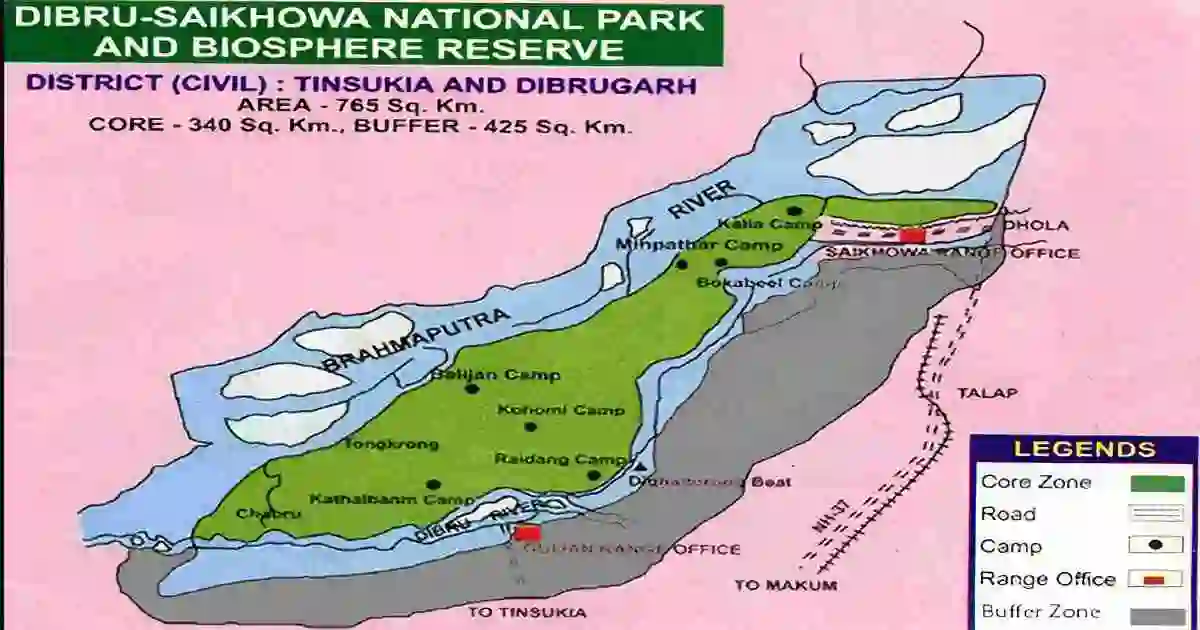
Dibru Saikhowa National Park Establishment
Originally the primary objective of the establishment of Dibru Saikhowa National Park was protecting the habitat of the rare white-winged wood duck. Over time its conservation efforts expanded to protect other endangered and vulnerable species. Dibru Saikhowa National Park is now home to various flora and fauna including the majestic Royal Bengal tiger, Indian leopard, clouded leopard, capped langur, Hoolock gibbon, Gangetic River dolphin, water buffalo, black-breasted parrotbill and many more. The park’s conservation has played a important role in preserving and safeguarding these rare and precious animals.
1. 1890: Declaration of Dibru Reserved Forest: In 1890, the area was officially declared as Dibru Reserved Forest. This marked the preliminary step in recognizing the importance of preserving the natural habitat and biodiversity of the region.
2. 1920: Addition to Dibru Reserved Forest: As recognition grew regarding the need for conservation, additional area was incorporated into the Dibru Reserved Forest in 1920. This expansion aimed to provide a larger protected space for the diverse flora and fauna.
3. 1929: Declaration of Saikhowa Reserve Forest: In 1929, the Saikhowa Reserve Forest was officially declared. This added reserve further strengthened the conservation efforts and emphasized the significance of protecting the natural resources of the area.
4. 1933: Expansion of Dibru Reserved Forest: Building upon the commitment to preservation, another expansion took place in 1933 expanding the Dibru Reserved Forest even further. This expansion helped in safeguarding a larger expanse of the unique ecosystems present in the region.
5. 1986: Preliminary Declaration of Wildlife Sanctuary: The year 1986 marked a significant milestone in the conservation journey of Dibru-Saikhowa. An area of 650 km2 was preliminarily declared as a wildlife sanctuary. This step reflected the growing recognition of the area’s ecological importance and the need for dedicated protection measures.
6. 1995: Final Declaration of Wildlife Sanctuary: After careful assessment and planning, in 1995, the preliminary wildlife sanctuary declaration was finalized. The official declaration encompassed 340 km2 of land, officially establishing the Dibru-Saikhowa Wildlife Sanctuary. This designated area provided a secure habitat for various endangered species and helped conserve their populations.
7. 1997: Establishment of Dibru-Saikhowa Biosphere Reserve: In 1997, the conservation efforts were further heightened with the establishment of the Dibru-Saikhowa as a Biosphere Reserve. Covering an area of 765 km2, this declaration recognized the special and sensitive environment present within the region. The 340 km2 sanctuary area was included as the core of the biosphere reserve emphasizing its importance in preserving biodiversity.
8. 1999: Declaration of Dibru-Saikhowa National Park: Finally, in 1999, the 340 km2 sanctuary area within the Dibru-Saikhowa Biosphere Reserve was designated as Dibru-Saikhowa National Park. This heightened status acknowledged the area’s exceptional ecological value and aimed to ensure its long-term protection and conservation.
9. 2020: Ecological and Wildlife Devastation: Baghjan Gas Blowout Impact on Dibru-Saikhowa National Park: The blowout, explosion and fire that occurred at Oil India Limited’s (OIL) gas well in Baghjan, Assam lasting for more than five months from May 27 to November 15, 2020, resulted in massive damage to the ecology and wildlife in the affected Dibru-Saikhowa landscape. An inquiry report submitted by Mahendra Kumar Yadava, Addl. Principal Chief Conservator of Forest and Chief Wildlife Warden, Assam reveals extensive damages to Dibru Saikhowa National Park.
a) Loss of Biodiversity and Habitat Damage: The blowout led to a loss of approximately 55% of biodiversity in the affected Dibru-Saikhowa landscape damaging 1,632 hectares of wetland, 523 hectares of grassland, 172 hectares of rivers and streams and 213 hectares of forest.
b) Magnitude and Impacts: The explosion generated a mushroom cloud reaching 2,500 meters into the sky and released around 0.1 million cubic meters of natural gas, equivalent to 0.9 kilotonnes of TNT. The flame’s temperature exceeded 1,200 degrees Celsius.
c) Human and Wildlife Casualties: Tragically, three human lives were lost along with the deaths of three animals listed under Schedule I of the Wildlife (Protection) Act, 1972. Over 29,000 scheduled and unscheduled wild animals and organisms perished as well.
d) Flaws in Environmental Clearance and Impact Assessment: The report identifies flaws in the Environmental Clearance (E.C.) issued by the Union Ministry of Environment, Forest and Climate Change in 2011, which failed to acknowledge the presence of the Dibru-Saikhowa National Park and the Bherjan-Borjan-Podumoni Wildlife Sanctuary within a 5-kilometer radius. The Environmental Impact Assessment (EIA) reports submitted by Oil India Limited were also deemed inadequate.
e) Consequences on Ecosystem and Wildlife: The blowout’s sound waves impacted the entire national park and parts of the wildlife sanctuary, disrupting habitats and causing damage to eggs, nests, and larvae. The Maguri Motapung Beel wetland, an Important Bird Area suffered significant ecological harm. Various animal populations, including Gangetic River dolphins, hoolock gibbons, fish, and bird species experienced adverse effects.
f) Monetary Valuation of Damages: The report estimates the damages to be valued at Rs.25,000 crore. Carbon earnings were assessed at Rs.18,234 crore during restoration, resulting in a net liability of Rs.6,800 crore over a 10-year period.
g) Recommendations for Future Precautions: The report highlights the need for improved environmental regulations, stricter evaluations of project sites and enhanced disaster response mechanisms to prevent such catastrophic incidents in the future.
10. 2020: Gauhati High Court Halts Oil India Limited’s Hydrocarbon Exploration in Protected Areas (December 2020): In a significant ruling, the Gauhati High Court on December 7, 2020, a Bench comprising acting Chief Justice N. Kotishwar Singh and Justice Manish Choudhury issued stayed the permission granted to Oil India Limited for hydrocarbon exploration in seven locations within protected areas. The court’s decision acknowledged the potential environmental and ecological risks associated with such activities emphasizing the importance of preserving protected areas and maintaining a balance between economic development and environmental sustainability.
Dibru Saikhowa National Park Geography and Climate
1. Geography of Dibru Saikhowa National Park
The geography of Dibru Saikhowa National Park is characterized by its location between the Brahmaputra and Dibru rivers. It spreads over a significant area and is known for its cover with wide range of semi-evergreen forests, deciduous forests, littoral, swamp forests and as well as patches of wet evergreen forests. These varied ecosystems extends to the park’s ecological richness which provides a wide range of plant and animal species to grow.
The park is divided into nine different wetland areas making a special and beautiful landscape. It includes about 35.84% wet forests, 9.50% degraded forests and 21.25% grasslands. It also has the biggest salix swamp forest in northeastern India, which makes it even more important for nature.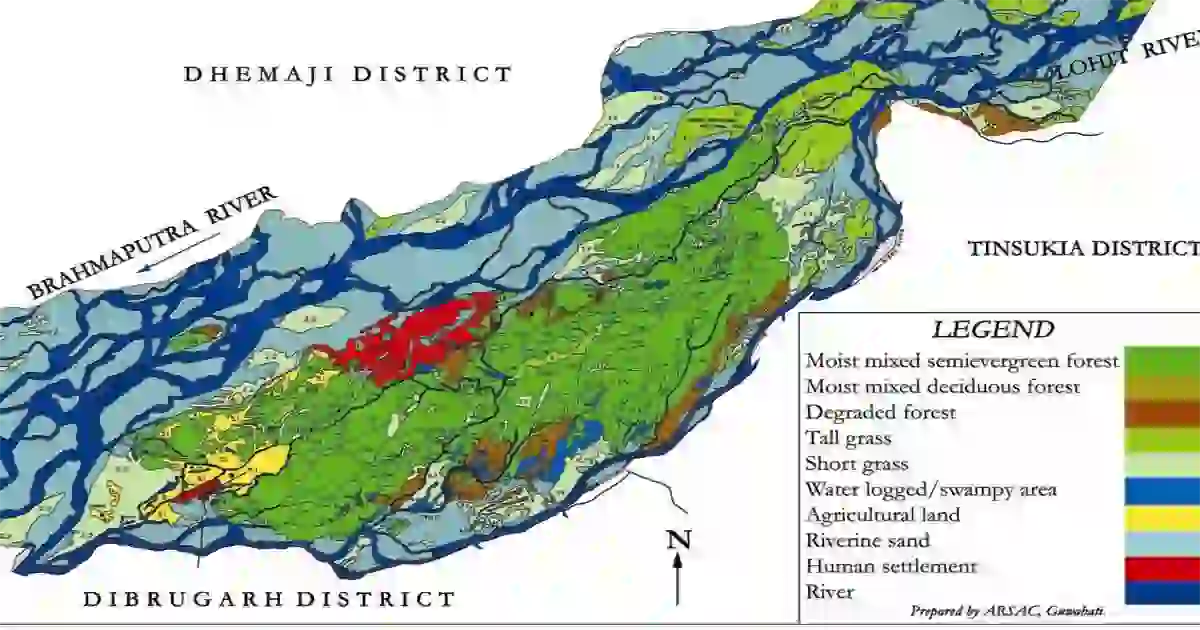
2. Climate of Dibru Saikhowa National Park
Dibru Saikhowa National Park experiences a tropical monsoon climate characterized by hot and wet summers and cold and dry winters. The park’s proximity to the Brahmaputra and Dibru rivers influences its weather patterns and enhances its biodiversity.
a) The Winter Season (November to April)
During the winter season, the park enjoys a cool climate coinciding with the period when the rivers dry up. This time of the year is ideal for outdoor activities of trekking and birdwatching. Thousands of migratory birds comes to the park during this season transforming it into a vibrant tapestry of colors and melodies. Birdwatching enthusiasts can find a multitude of species including Ruddy Shelducks, Cormorants, Drongos, Kingfishers, Hornbills, Mynas, Bar Headed Geese, Purple Swamphens and more. The Maguri Beel near Dibru Saikhowa National Park is particularly renowned for birdwatching during the winter months.
b) The Summer Season (May to August)
In summer, Dibru Saikhowa National Park experiences slightly hot and humid weather. The lush greenery flourishes, creating a vibrant atmosphere within the park.
c) The Monsoon Season (June to September)
Monsoons bring relief from the humidity, typically lasting from June to September. During this season, the park receives pleasant rains, rejuvenating the landscape and replenishing the water bodies from the Dibru and Brahmaputra rivers. The climate ranges from approximately 25 to 33 degrees Celsius. Annual rainfall ranges from 2300 to 3800 mm. During the rainy season, the park becomes beautiful with blooming orchids which attract visitors. Visitors can go on houseboat rides and explore the park’s islands. Seeing the colorful orchids and different animals makes for a great adventure.
The different landscapes and weather in Dibru Saikhowa National Park make it a great place for nature lovers. Visitors can enjoy different things there all year round like watching birds in winter, exploring in summer and having adventures in the rainy season. There are so many natural things to see and do in the park.
Forests and Biodiversity in Dibru Saikhowa National Park
1. Forest Composition in Dibru Saikhowa National Park
The forest composition of Dibru Saikhowa National Park includes a variety of forests such as semi-evergreen, deciduous, littoral, and swamp forests, along with patches of wet evergreen forests. The park’s forest cover includes about 35.84% moist mixed forest, 9.50% degraded forest and 21.25% grassland. These various forest types contribute to the park’s rich biodiversity and provide for numerous plant growth and habitats for animal species.
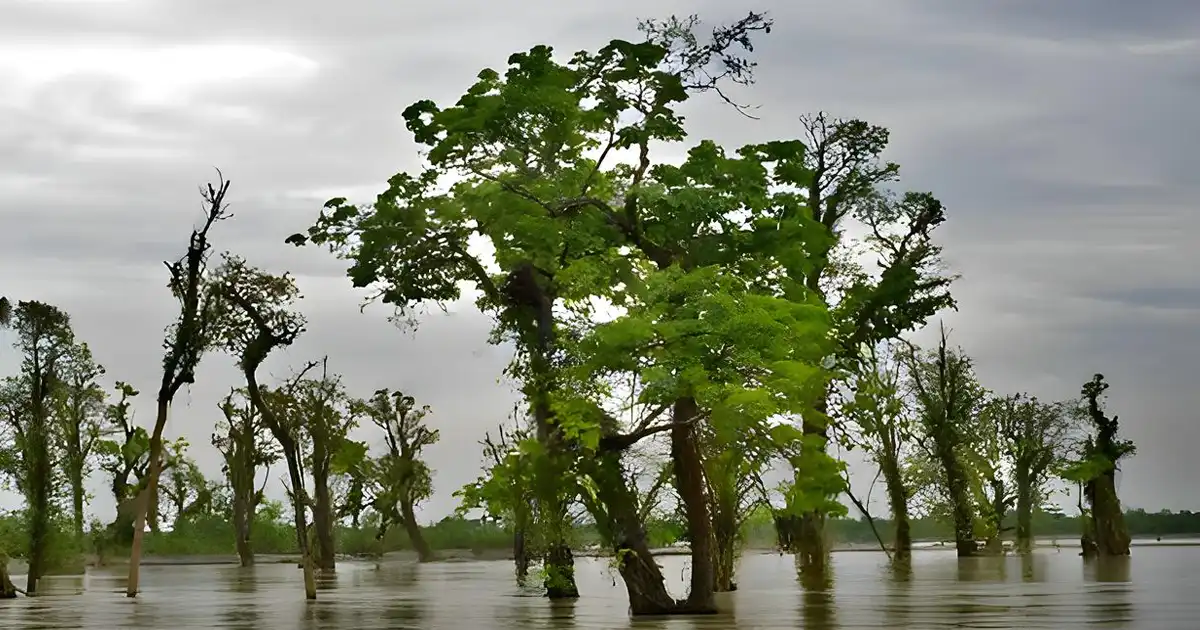
a) Prominent Tree Species
Within the park several important tree species contribute to the lively forest landscape. Among the major tree species found in Dibru Saikhowa National Park are Dillenia indica, Mesua ferrea, Lagerstroemia parviflora, Bischofia javanica, Terminalia myriocarpa, Ficus, Tetrameles nudiflora, Dalbergia sissoo and Bombax ceiba. These trees support the forest environment and play a vital role in supporting the park’s biodiversity.
b) Grasses in the National Park
In addition to the various forest types, the national park is characterized by various grasses which contribute to the overall ecological balance. Some principal types of grasses found in Dibru Saikhowa National Park include Arundo donax, Imperata cylindrica, Phragmites karka, and Saccharum ravennae. These grasses provide essential food sources, habitats and nesting spaces for a wide range of wildlife species.
c) Orchids in Dibru Saikhowa National Park
The park has many different types of orchids that grow on trees and on the ground making it even more beautiful with all the different plants. A total of 35 species of epiphytic orchids and 8 species of terrestrial orchids have been recorded in Dibru Saikhowa National Park.
The mix of different forests, lots of trees, growing grass and many orchids make Dibru Saikhowa National Park a special place with lots of different plants and animals.
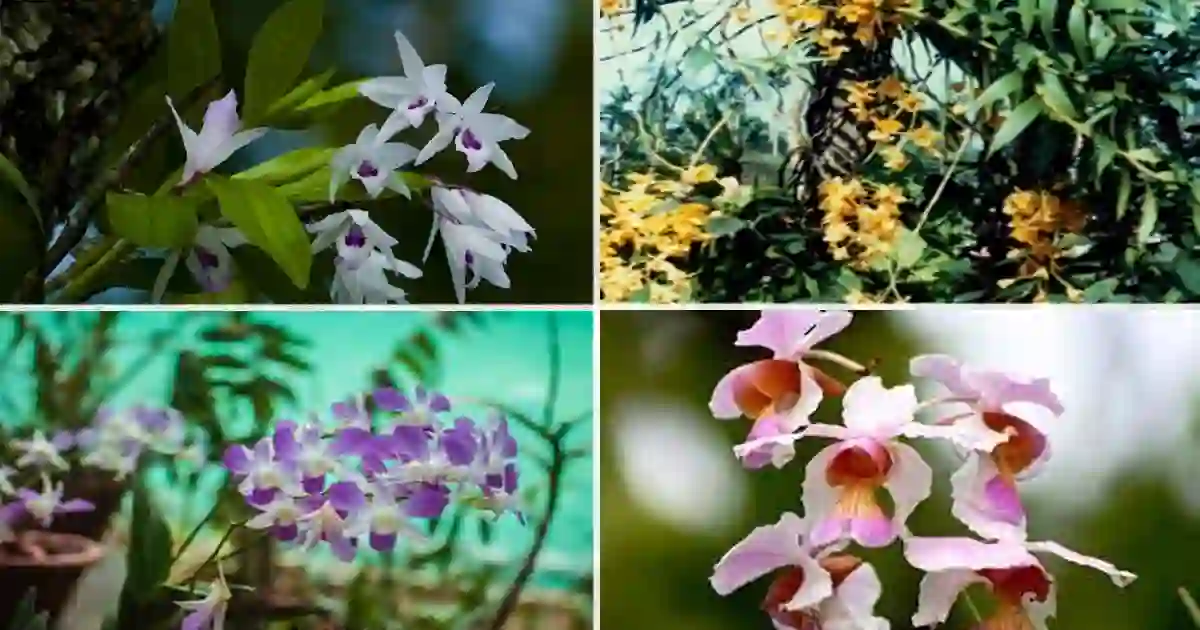
2. Diverse Fauna of Dibru Saikhowa National Park
a) Mammals
Dibru Saikhowa National Park has a variety of mammal species, with a total of 36 recorded. Among them 12 species are listed in Schedule 1 of the Wildlife (Protection) Act of 1972 indicating their significance for conservation efforts. The park is home to various animals such as the Bengal tiger as the Bengal tiger, Indian leopard, clouded leopard, jungle cat, sloth bear, dhole (Indian wild dog), small Indian civet, Sambar deer, Malayan giant squirrel, Chinese pangolin, barking deer, Asiatic water buffalo, wild boar, slow loris, hog deer, Hoolock gibbon, Ganges dolphin, Assamese macaque, pig-tailed macaque, rhesus macaque, capped langur, the Asian elephant. and feral horses.
b) Reptiles
Dibru Saikhowa National Park is also home to a diverse range of reptiles. Among the recorded reptiles, 2 species of monitor lizard, 8 species of turtles and 8 species of snakes have been documented. These reptiles contribute to the park’s intricate food webs and play an important role in maintaining the ecological balance.
c) Avifauna
The park’s avifauna is equally impressive with a wide variety of over 300 bird species making it their home. Notable bird species recorded in Dibru Saikhowa National Park are-
- Greater Adjutant: Large wading bird with a distinctive pouch-like neck
- Ferruginous Pochard: Medium-sized diving duck with a reddish-brown body
- Jerdon’s Babbler: Small passerine bird known for its melodious song
- Black-breasted Parrotbill: Colorful bird with a black breast and curved bill
- Marsh Babbler: Small bird found in marshy habitats
- Puff-throated Babbler: Babbler species with a distinct puff-like throat
- Jerdon’s Bushchat: Small passerine bird with a bushy tail
- Rufous-rumped Grassbird: Grassland bird with a rufous-colored rump
- Chestnut-crowned Bush Warbler: Warbler species with a chestnut crown
- Swamp Francolin: Game bird found in swampy areas
- Spot-billed Pelican: Large water bird with a distinctive spot on its bill
- White-bellied Heron: Heron species with a white belly and long neck
- Grey Heron: Large wading bird with a grey plumage
- Purple Heron: Heron species with a purple-colored plumage
- Black-crowned Night Heron: Nocturnal heron species with black crown feathers
- Yellow Bittern: Bittern species with yellow plumage
- Asian Openbill: Stork species with a distinctive gap in its bill
- Lesser Adjutant: Large wading bird closely related to the Greater Adjutant
- White-necked Stork: Stork species with a white neck and black body
- Black Stork: Large stork species with a black plumage
- Black-necked Stork: Stork species with a black neck and white belly
- Glossy Ibis: Ibis species with glossy dark plumage
- Fulvous Whistling-Duck: Duck species with a fulvous (tawny) plumage
- Bar-headed Goose: Goose species with distinctive bar-like markings on its head
- Greylag Goose: Large goose species with a grey plumage
- Northern Pintail: Duck species with a long, pointed tail
- Common Shelduck: Large duck species with a reddish-brown plumage
- White-winged Wood Duck: Large duck species with white wing patches
- Indian Spot-billed Duck: Duck species with a spot on its bill
- Baer’s Pochard: Endangered diving duck with a distinctive head shape
- White-tailed Eagle: Large eagle species with a white tail
- Pallas’s Fish Eagle: Fish-eating eagle species with a distinctive crest

Best Time to visit Dibru Saikhowa National Park
The best time to visit Dibru Saikhowa National Park is at some point during the winter season which spans from November to February. The weather all through this time is relatively cooler and more pleasant with temperatures starting from 7°C to 22°C (45°F to seventy-two° F). The park is at its best during these months with lots of chances to see wildlife and birds.
In winter, lots of birds that fly to different places come to the park making the variety of birds there even bigger. You can see many different kinds of birds like ducks, hawks, and small songbirds. The park’s grassy areas and wet areas are full of animals, and you can also see many different mammals like tigers, leopards, elephants, and deer.
It’s important to note that Dibru Saikhowa National Park experiences a monsoon season from June to September which brings heavy rainfall and makes the park inaccessible and prone to flooding. Therefore it is advisable to avoid visiting during this period.
1. How to Reach Dibru Saikhowa National Park
a) By Air: Dibrugarh Airport, located in Mohanbari is the closest airport to the park, just 40 km away. The other airport, Guwahati Airport is 500 km from Dibru Saikhowa National Park.
b) By Train: The closest railway station to the Guijan and Dhola entry points of Dibru Saikhowa National Park is Tinsukia railway station. It’s 10 km away from Guijan and 50 km away from Dhola
c) By Road: Tinsukia is well-connected to major cities in Assam. Regular buses travel to and from Tinsukia are available.
2. Where to Stay Options at Dibru Saikhowa National Park
There are lots of eco-friendly resorts near the park. They give you a special eco-tourism experience with traditional cottages, pretty views, and tasty Assamese food. The Dibru Saikhowa Eco Camp, managed by an NGO committed to promoting ecotourism, offers accommodations, meals and guided tours to explore the park and its attractions. Conveniently located next to the Banashree Eco Resort, the camp warmly welcomes visitors to explore the park’s natural beauty.
Exploring Dibru Saikhowa National Park
1. Maguri Beel:
A Haven for Birdwatching Located near Dibru Saikhowa National Park, Maguri Beel is a picturesque lake surrounded by mixed grasslands. This non-protected area attracts numerous grassland birds and waterfowl. Visitors can spot a variety of bird species, including Ruddy Shelducks, Egrets, Lesser Adjutant, Baikal Teal, and many more. The lake is also rich in aquatic life, making it a biodiverse habitat.
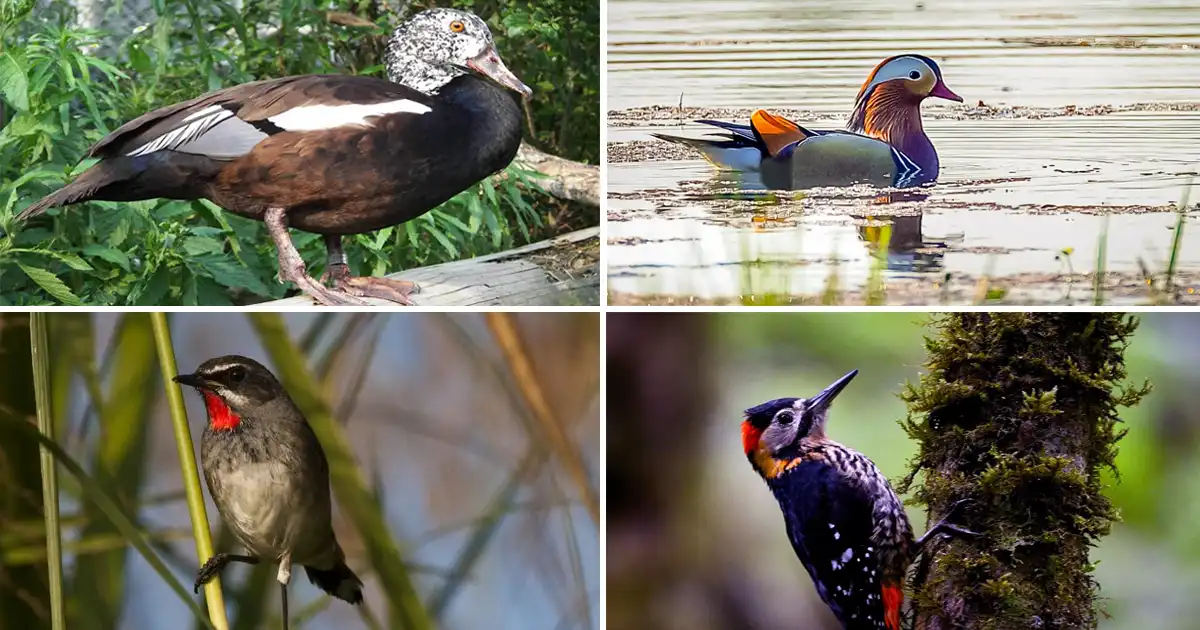
2. Kekjori Tree:
A Centuries-Old Attraction Situated within Dibru Saikhowa National Park, the Kekjori tree is a famous landmark. With its sprawling branches and rich folklore, this over a hundred year old tree has captivated tourists for generations. The tree is considered sacred by the local villagers who believe it brings bad luck to cut its branches. Visitors can hire a boat and trek for 30 minutes to reach this unique attraction.
En route to the Kekjuri tree, you’ll pass Saal Beel, a small lake in Dibru Saikhowa National Park. It harbours a variety of migratory and resident bird species, including the magnificent Ruddy Shelducks. Take a moment to witness these majestic avian species. Additionally, Saal Beel is renowned for its Saal fish adding to the area’s fame.
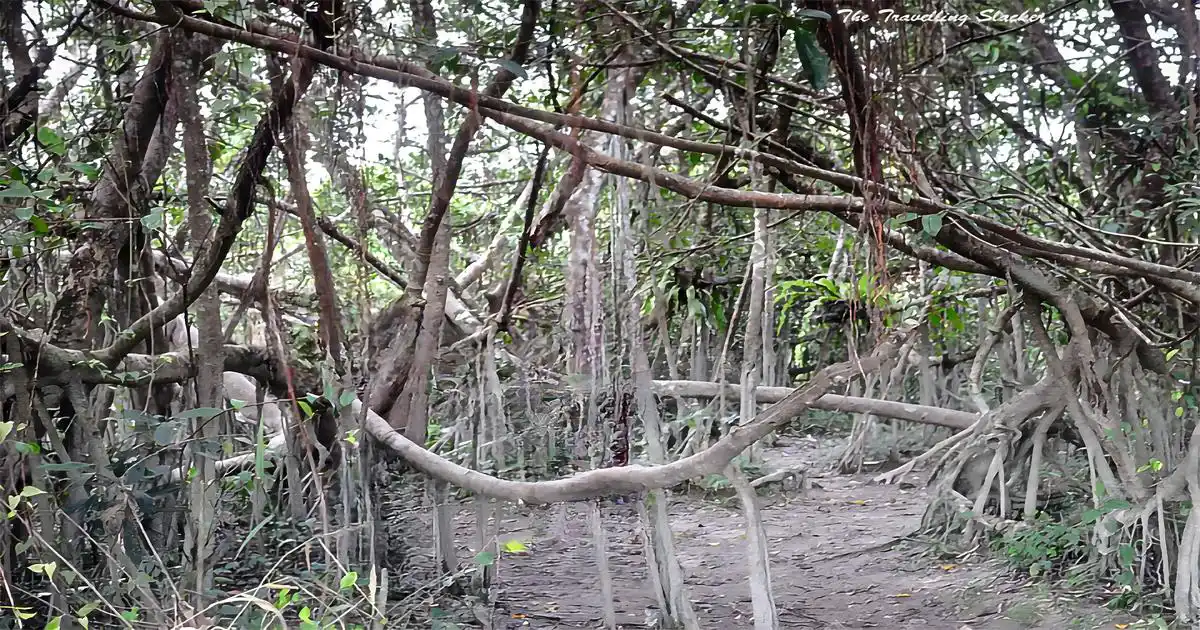
3. Churkey Sapori:
Home of the Feral Horses Churkey Sapori, an island in Dibru Saikhowa National Park is renowned for its population of feral horses. Originally domesticated and abandoned during World War II by the British Army, these horses have adapted to the wild and now thrive in the park. They are the third and fourth generation of feral horses, with approximately 50 individuals. These horses renowned as Misakai Horse in Japan, Brumby horses in Australia, and Mustangs in the United States, fascinate visitors with their ability to survive in the wild.
They can be seen in herds, sometimes up to 20 horses, particularly during the monsoon season when the rivers are full and house boats provide an opportunity for wildlife sightings. Embark on a memorable river cruise in Dibru Saikhowa National Park to witness the wilderness and encounter these remarkable feral horses.
4. Laika Forest Village:
Immersion in Tribal Life Laika and Dodhia are forest villages inhabited by local tribes within Dibru Saikhowa National Park. The Mishing, Muttock, Moran and Sonowal Kachari tribes reside here showcasing their traditional customs and way of life. Exploring these villages provides a glimpse into rural village living and age-old traditions offering a unique cultural experience.
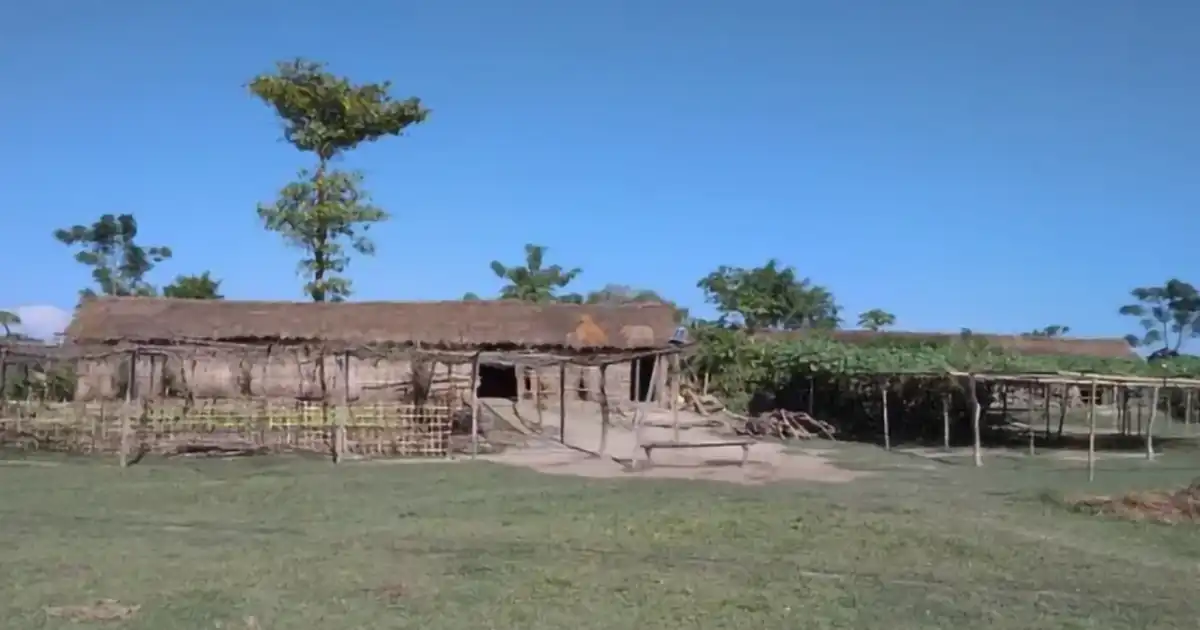
5. Boating on River Dibru:
Dolphin Sighting Adventure A boat ride along River Dibru within the national park offers an opportunity to spot the elusive River Dolphins. These endangered creatures inhabit the protected waters of Dibru Saikhowa National Park. Patience, keen observation and binoculars are key to catching a glimpse of these majestic and friendly creatures. The boat tour also allows for the exploration of diverse flora and fauna.
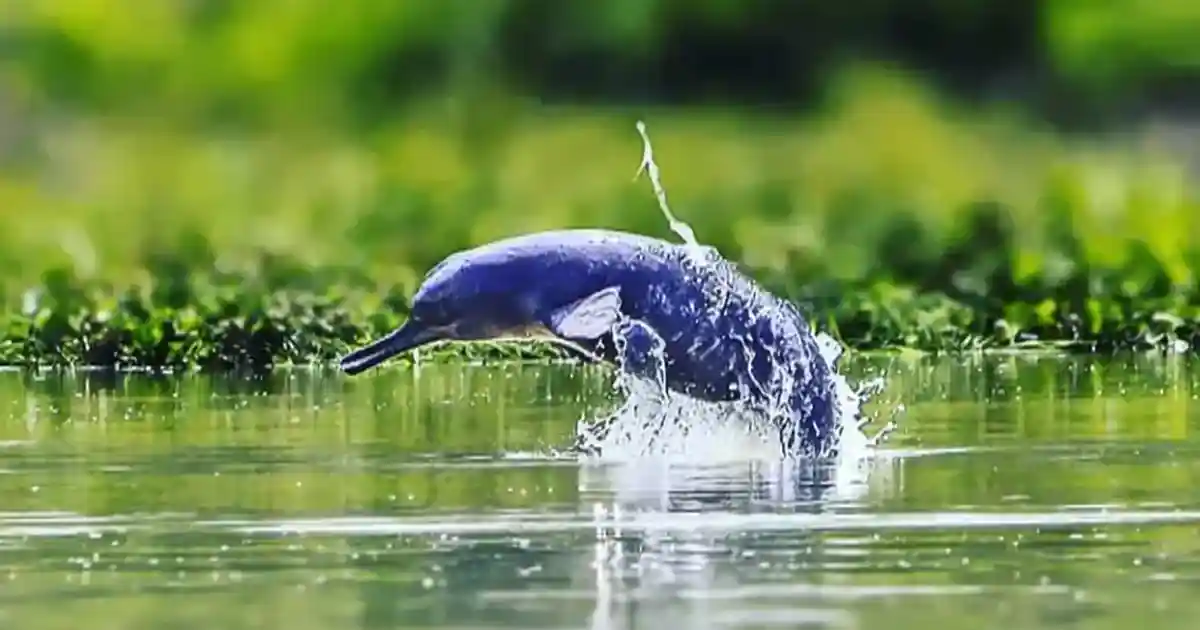
6. Barekuri:
Encounter with Hoolock Gibbons Barekuri village near Dibru Saikhowa National Park is known for its tranquil environment and abundant wildlife. It is home to the endangered Hoolock Gibbons and Slow Lorises. Visitors can witness the unique behavior and calls of these primates. While the area is not a designated protected zone, the village coexists with these fascinating creatures making it an increasingly popular destination for nature enthusiasts.
Conclusion
Dibru Saikhowa National Park in Assam is a haven for nature lovers offering a mesmerizing blend of biodiversity and natural beauty. From the thriving wetlands and lush tea gardens to the remarkable feral horses and migratory bird species the park is a paradise waiting to be explored. With its serene atmosphere and diverse wildlife Dibru Saikhowa National Park provides a tranquil escape where visitors can immerse themselves in the wonders of nature and create lasting memories.
FAQ
1. Dibru Saikhowa National Park is famous for?
Dibru Saikhowa National Park is famous as a Biosphere Reserve and It is also known for its feral horses. Originally established to safeguard the natural habitat of the elusive white-winged wood duck, Dibru Saikhowa National Park now serves as a sanctuary for a diverse range of endangered species.
2. Where is Dibru Saikhowa National Park?
Dibru Saikhowa National Park is located in Dibrugarh and Tinsukia of Assam, India.
3. Which National Park is famous for wild horses in Assam?
Dibru-Saikhowa National Park is famous for its huge population of feral horses. There are around 50 feral horses.
4. What is the other name of Dibru-Saikhowa National Park?
Dibru Saikhowa National Park was earlier known as Dibru Reserve Forest and Saikhowa Reserve Forest. It was notified as a wildlife sanctuary in 1986, a biosphere reserve in 1997 and a national park in 1999.
You May Also Like
- Dehing Patkai National Park
- Orang National Park
- Raimona National Park
- Nameri National Park
- Manas National Park
References
- Dibru Saikhowa National Park site: https://tinsukia.assam.gov.in/

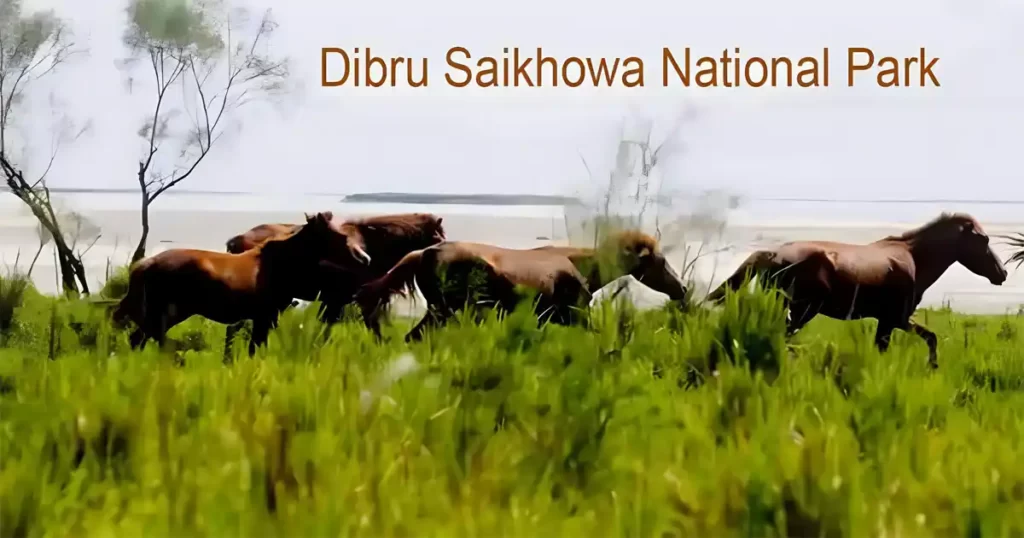



3 thoughts on “Dibru Saikhowa National Park”